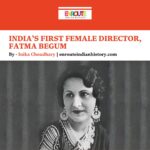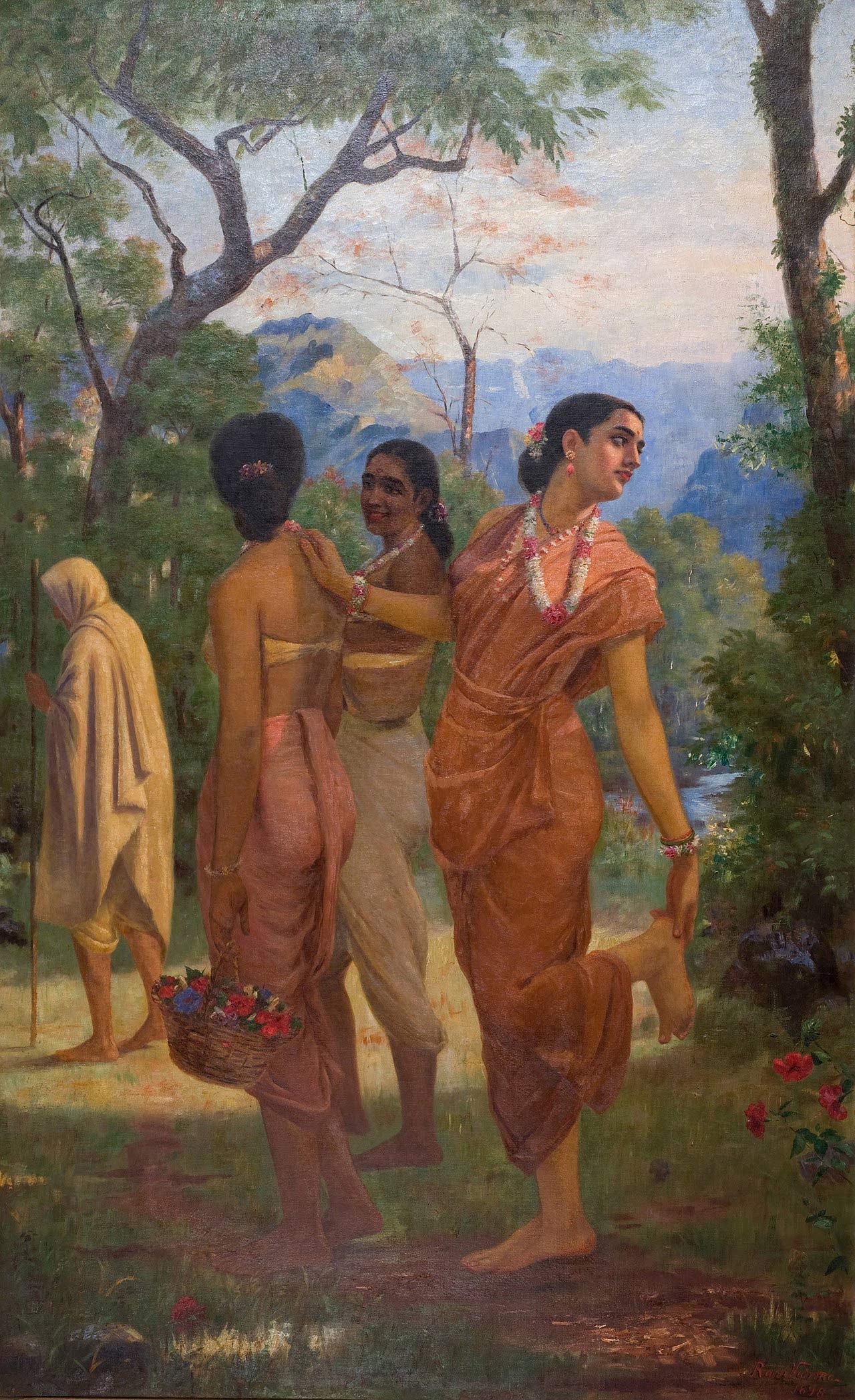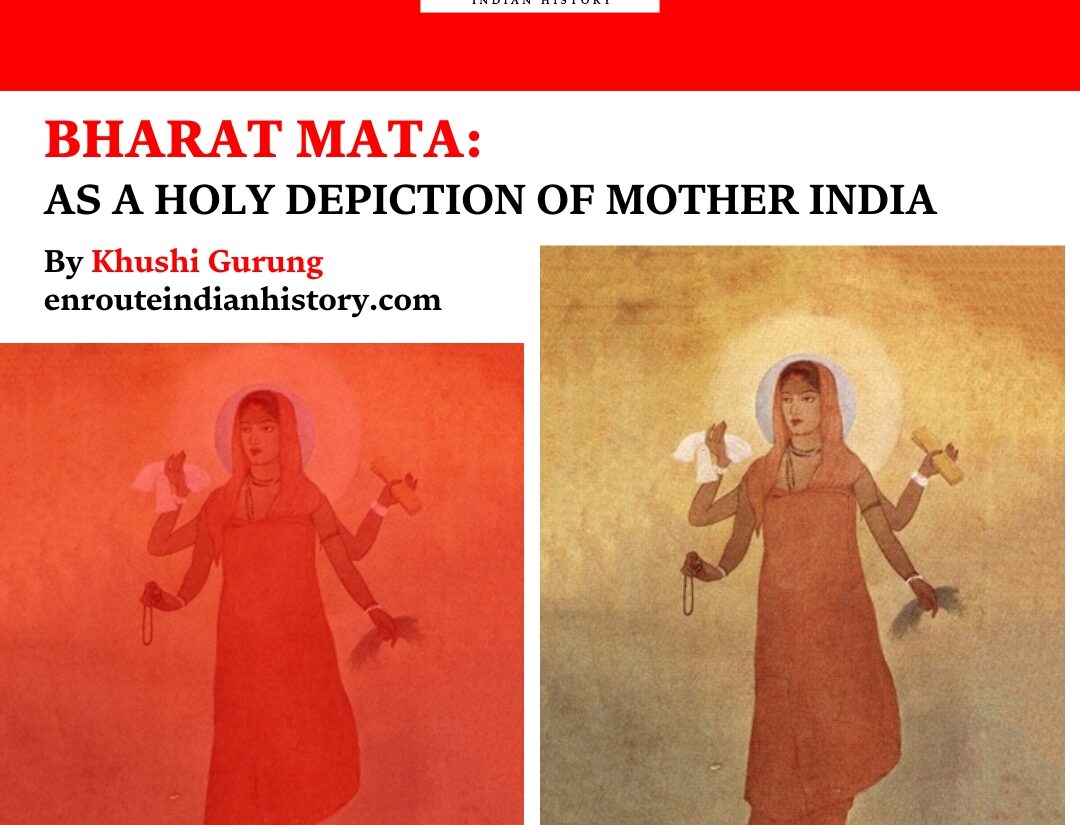

Source: Goddess and the Nation, Bharat Mata by Roop Kishor Kapoor 1931
“Bharat Mata ki Jai!” is a common slogan that one is bound to hear every now and then in India, especially during patriotic events which depicts a sense of nationalism. Nationalism spreads when people begin to believe that they are all part of the same nation, when they discover some unity that binds them together. But how did the nation become a reality in the minds of people? How did people belonging to different communities, regions or language groups develop a sense of collective belonging during India’s freedom struggle? This sense of collective belonging came partly through the experience of united struggles. But there were also a variety of cultural processes through which nationalism captured people’s imagination. History and fiction, folklore and songs, popular prints and symbols, all played a part in the making of nationalism. The identity of the nation is most often symbolised in a figure or image. This helps create an image with which people can identify the nation. It was in the twentieth century, with the growth of nationalism, that the identity of India came to be visually associated with the image or painting of Bharat Mata. As the embodiment of Mother India, Bharat Mata which transcends mere artistic expression, evolved into a powerful symbol of national identity and devotion. Her portrayal not only fuelled the flames of independence but also wove together the diverse threads of a nation yearning for freedom. This personification of India through Bharat Mata was a very interesting and important notion that took birth during India’s freedom struggle against the British during the 20th century but also created debates and controversies regarding its depiction.
The Creation and Evolution of Bharat Mata
According to some sources it is said that the first origin or the idea of Bharat-Mata, the goddess of the Indian nation state, emerged after the 1857 Uprising when the idea of India as a ‘single nation state’ — rather than a collection of states — became prominent. This is when people of different kingdoms and different strata of society came together, in whatever disorganised manner, to challenge the East India Company. This eventually gave rise to the idea of Bharat Mata.
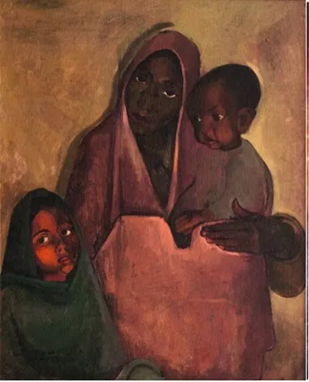
Source: PaintPhotographs, Mother India Amrita Shergill 1935, oil on canvas.
The first time we hear of a national mother goddess is in a Bengali play ‘Barat Mata’ written by Kiran Chandra Banerjee in 1873. It deals with the 1770 Bengal famine and how people are motivated by a goddess to rise in rebellion against the Company. In 1882, the theme of the sanyasi rebellion against the British emerges once again in the novel Anand Mutt by Bankim Chandra Chatterjee. He introduces the concept of Vande Mataram or salutation to the mother. But the ‘mother’ over here is personification of the nation, and the nation is Bengal, not Bharat. It was during the Bengal Renaissance (a period of cultural and intellectual awakening in Bengal in the 19th -20th century) that the concept of Bongo Mata emerged which was similar to Bharat Mata.
In the year 1905, the then Viceroy of India, Lord Curzon, decided to divide Bengal into two parts under his notorious Divide and Rule policy. The eastern part would be for Muslims, and the western part for Hindus. This policy would create tension among the two religions, who would forget about fighting the British to fight among themselves. Rabindranath was strongly opposed to this and led the movement against the Partition of Bengal, taking to the street to tie rakhis on Muslims. Then came Abanindranath Tagore who painted the image of Bongo Mata to uprise the nationalist feeling among the people against the harsh British rule. It was also stated that when the Britishers established education system in India in all western patterns and even the art colleges and institutes were starting to practice western art style, Abindranath Tagore then established the Bengal School of Art which promoted Indian art styles and created a woman to bring back our own Indian authentic style. Abindranath has visualised Bankim Chandra Chatterjee’s celebrated national poem to create this painting. The origin of the painting Bharat Mata by Abanindranath Tagore is deeply rooted in the socio-political and cultural context of early 20th-century India. By 1930s, Bongo Mata becomes Bharat Mata. As the map of India was unveiled by the British rulers of the land, the image was personified as a woman —Bharat Mata. Although numerous depictions of Bharat Mata emerged during the pre-independence struggle, for instance Raja Ravi Varma’s 1898 painting of Bharat Mata and Amrita Shergill’s 1935 painting of the same, it was Abanindranath Tagore’s painting of Bharat Mata that became the most widely recognized and circulated image, significantly fostering a sense of nationalism among the people of India.
Bharat Mata by Abindranath Tagore

Source: ArtWorkonly, Bharat Mata painting of Abindranath Tagore, Watercolour painting, 1905
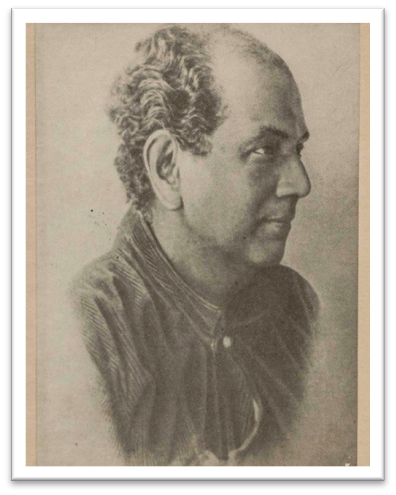
When the Britishers established education system in India in all western patterns and even the art colleges and institutes were starting to practice western art style, Abindranath Tagore established the Bengal School of Art which promoted only Indian art styles and created a woman to bring back our own Indian authentic style. This was the painting of Bharat Mata. Unlike popular Indian goddesses, Bharat Mata, represented by Tagore, is a simple yet godly young woman clads in a plain saffron saree draped in the Bengali style. Even though she is unembellished, she radiates immense beauty. Here, she does not look like a goddess, but a simple traditional Indian woman. It is her multiple hands and the halo around her head that gives her a divine appearance. In her four hands, she holds a Rudraksha mala, a white cloth, sheaves of paddy, and a palm leaf manuscript. The Rudraksha mala is strongly associated with Shaivism and is also known as the beads of salvation. Thus, it represents the spiritual strength of the nation. The piece of white cloth that she holds refers to the clothing that we wear. While the white colour may be a symbol of peace, it may also represent cotton, which has always been an important contributor to India’s economy. The palm manuscripts are the Vedas that are the source of all knowledge and reflect the country’s strong educational background. Lastly, the rice paddy emphasises the rich food that our country produces. Thus, Tagore’s Bharat Mata is a personification of India’s rich economy and cultural heritage. The Bharat Mata depicted by Tagore is a gentle, vulnerable, and saintly figure that acts as a reminder of the many gifts our motherland grants us- Shiksha (knowledge), Diksha (spiritualism), anna (food), and Vastra (clothing) and these features maybe the reason that gives a unique spark to the painting. The colour palette of Bharat Mata is dominated by saffron and earthy tones. The use of saffron, a colour often associated with Hindu spirituality and sacrifice, reflects the religious and cultural significance of the figure. The boundary of the central figure is framed with an ornate border, which further accentuates the artwork’s devotional quality.
Under the Bengal School of Art, Abindranath Tagore developed a distinctive style that combined elements from classical Indian art with contemporary techniques. This approach was characterized by its use of Indian motifs, simplified forms, and a focus on spiritual and cultural themes. His style was less concerned with realism and more with expressing inner emotions and symbolic meanings. Tagore’s vision extended beyond mere aesthetics; he aimed to create a visual language that could articulate the cultural and spiritual aspirations of India. His work emphasized the spiritual and national identity of the Indian people, which was especially significant during the nationalist movement.
Bharat Mata as Religious and Political medium
The painting holds a profound religious significance that transcends its political and cultural symbolism that shows the portray Bharat Mata, or Mother India, as a divine and maternal figure, embodying the spiritual essence of the nation. The personification of India through Mother India was a very interesting and important notion that took birth during India’s freedom struggle against the British. As can be seen from the history of our country, almost every clan, whether it be the Rajput kings or the Marathas, had a clan goddess who was worshipped before the kings led their armies to the battlefields. It was believed that the blessings of the goddess would lead them to victory. Thus, clan goddesses were a symbol of hope and triumph. So, it can be said that this belief also inspired the creation of the Bharat Mata.
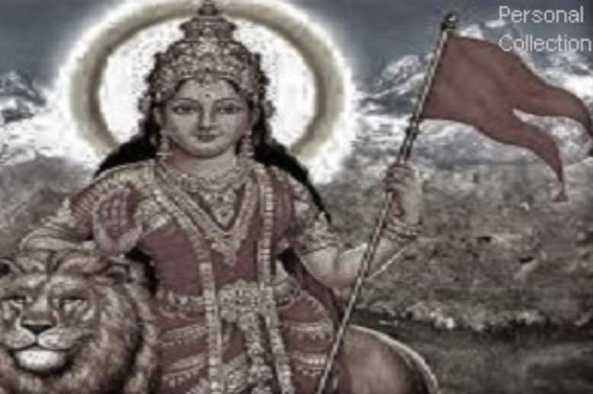
In India, Goddesses, especially those associated with warfare, such as Durga and Kali, have a strong iconography and is also given a mother figure. While Durga is shown riding a mighty tiger (or lion), Kali’s garland of severed heads and skirt of severed hands vividly depict her ferocity. Such depictions of powerful goddesses conditioned people’s imagination in a way. Hence, Bharat Mata’s image too, was imagined as a nearly similar portrayal of strength and valour during the independence era. In Indian tradition, the concept of the Divine Feminine is deeply revered, with goddesses playing pivotal roles in both mythology and daily worship and the association of Goddess with ‘Mata’ (meaning mother in Hindi). By portraying India as a mother figure, artists taps into this cultural and religious archetype, evoking the image of the nurturing and protective mother who is both a provider and a protector. This maternal aspect of Bharat Mata resonates with the notion of “Vasudhaiva Kutumbakam,” the world as one family, where the land itself is seen as a nurturing mother to all her children, regardless of their background.
The portray of Bharat Mata also became a medium of political expression through literally during the freedom struggle. Ever since the time of human civilization, art and literature have played a crucial role in building and strengthening society. Works of art and literature are still held as symbols of status and influence, they have contributed immensely in uniting people and pointing out the evils of society. Additionally, governments and individuals around the world have also used art and literature to fuel hatred and propaganda. Such is the role of the arts in bringing change. Similarly, novels, songs, paintings and journals were all important factors which helped India unite against the British and fight for independence. With this the image of Bharat Mata also prevailed among the people through novels, newspapers, plays and paintings. For instance, as mentioned before, novels, paintings and plays related to Bharat Mata played a significant role to influence national pride among the people.
Furthermore, before the advent of Gandhi Bengali nationalism swept the country providing the ideological flavour to the new idea of nationalism and religious reforms. Tamil poet C. Subramania Bharathi, no doubt influenced by Bengali traditions, wrote a poem extolling Tamil, the Tamils, Bharata and ended with what was fast becoming a clarion call of the freedom struggle, ‘Vande Mataram’ (I worship you mother). The poem published around the customary New Year celebrated according to Tamil calendar, April 20th 1907, was featured in the magazine ‘Inthiya’, run by Bharathi. The cover of that issue featured a lady seated on rock, her hand resting on a globe showing the map of India and Indians, a Hindu, a Muslim, and others, paying obeisance to her. Bharathi used such imagery often. Another image published on April 10th 1909 showed a lady, super imposed within the cartographic representation of India with babies suckling at her breasts, as before Indians of various religions looking up to her, the words “Vande Mataram”, in Devanagari script, on the right and even a ‘Allahu Akbar’, in Urdu and in relatively diminutive script of the left. From then on, the image of Bharat Mata became an icon for creating nationalistic feelings among Indians during the freedom struggle. Later journals and newspapers came up to be an important medium of communication to the masses. Historians say that Sister Nivedita, an admirer of Tagore’s painting, wanted to carry the painting from Kashmir to Kanyakumari to spread nationalist passion among the people of the country. These are major ways through which freedom fighters used words and arts to create unity among people and build a vision of an India independent of foreign control. These mediums turned out to be crucial for organizing masses and bringing change, which is still relevant to this day.
Controversies
During the freedom struggle, Bharat Mata was often depicted as a goddess-like figure, drawing parallels with Hindu deities such as Durga or Saraswati. This portrayal resonated deeply with many Hindus, but it also raised concerns among other religious communities. The image of Bharat Mata as a divine mother figure was seen by some as inherently Hindu, potentially alienating Muslims, Christians, and other religious groups in India. Critics argued that the symbol of Bharat Mata could inadvertently impose a Hindu-centric view of nationalism, thereby excluding those who did not share this religious framework. The use of Bharat Mata in religious contexts has further fuelled controversy. Temples dedicated to Bharat Mata have been established in various parts of India, where she is worshipped alongside other Hindu deities. This religious veneration of Bharat Mata as a divine figure blurs the lines between religious devotion and national patriotism, leading to questions about the secular nature of the Indian state. Critics argue that the worship of Bharat Mata in temples reinforces the idea that being Indian is synonymous with being Hindu, which contradicts the secular principles enshrined in the Indian Constitution. According to sources, a proposed Bharat Mata temple in Tamil Nadu faced protests from local communities, who argued that the temple was being used to promote a particular political ideology rather than a genuine spirit of national unity. The controversy highlighted the challenges of balancing religious symbolism with the need for inclusivity in a pluralistic society. This has sparked debates over whether the image of Bharat Mata can truly represent a secular nation if it is primarily associated with Hindu religious practices. In response to the perceived Hindu-centric nature of Bharat Mata, some religious groups have explicitly rejected the image.
In contemporary India, the image of Bharat Mata continues to be a contentious symbol, especially when used by political groups. Hindustan Times had mentioned what Smriti Irani, the then minister of HRD, said regarding the Bharat Mata controversy in 2016, “What (Bharat Mata) we pray to and worship is a subject of controversy for some people. This itself is a matter of worry and shows us the kind of challenging times we are passing through… As a citizen, I do feel that if Bharat Mata is not hailed in India, then where else she would be hailed,” she told reporters. Hindu nationalist organizations, such as the Rashtriya Swayamsevak Sangh (RSS) and the Bharatiya Janata Party (BJP), often invoke Bharat Mata in their rhetoric and imagery. This association has sparked concerns that Bharat Mata is being used to promote a Hindu nationalist agenda, which could marginalize religious minorities. For example, in 2016, a controversy erupted when some Muslim leaders and students at Aligarh Muslim University refused to chant “Bharat Mata ki Jai” (Victory to Mother India), arguing that it was against their religious beliefs. After Hindutva organisation RSS said the young should be taught chanting the slogan, Assauddin Owaisi asserted that he would not do so even if a knife is put at his throat! This incident led to a heated national debate, with some accusing the refusal of being unpatriotic.
Conclusion
The depiction of Bharat Mata has evolved from a symbolic representation of the nation to a multifaceted cultural icon deeply embedded in India’s national consciousness. Initially popularized by Abanindranath Tagore’s seminal painting, Bharat Mata emerged as a unifying figure during the independence struggle, embodying the aspirations and resilience of a nation seeking freedom. Her image served as a powerful tool in rallying support, fostering a collective identity, and inspiring patriotic fervour across diverse communities. In contemporary times, Bharat Mata continues to resonate in both traditional and modern contexts, appearing in art, media, and public discourse. While her portrayal has contributed to a sense of national pride and unity, it has also sparked debates about inclusivity and secularism, reflecting the complex nature of Indian identity. As a cultural symbol, Bharat Mata embodies the ongoing dialogue between tradition and modernity, nationalism, and diversity, illustrating her enduring significance in shaping India’s national narrative.
Bibliography
Rana, Akshita, 2020, “Why is Abanindranath Tagore’s Bharat Mata Painting Unique?”, Pratha, Available at: https://www.prathaculturalschool.com/post/bharat-mata-painting
Gosh, Dhrubhaa, 2020, “The true story behind Abanindranath Tagore’s Bharat Mata painting”, HT School.
Smith, J. A. (2023). “The evolution of Bharat Mata in Indian art”, Journal of Indian Art Studies, 15(2), 45-60. Available at: https://doi.org/10.1234/jias.2023.5678
Sharma, Mahima, 2023, “Bharat Mata (Painting): A Holy Depiction of Mother India”, Simplykalaa, Available at: https://simplykalaa.com/bharat-mata-painting/#1_Artists_Statement
GetBengal, 2021, “Painting that had the idea of Bharat Mata”
PaintPhotographs, 2023, “100 Years of Bharat Mata: 9 Iconic Indian Artworks by Legendary Artists”.
Bansal, Avani, 2023, “Bharat Mata : Not An Idea Supported By The Constitution”, The Womb, Available at: https://www.thewomb.in/bharat-mata-not-an-idea-supported-by-the-constitution/
Athenaeum, 2016, “Bharat Mata Ki Jai: A Reaction to Colonialism or Ancient Tradition? Was Irfan Habib wrong?”, ContranianWorld.
- artists depicting Bharat Mata
- Bharat Mata and patriotism
- Bharat Mata art
- Bharat Mata in Indian art
- Bharat Mata in Indian culture
- Bharat Mata painting
- Bharat Mata portrait
- Bharat Mata symbolism
- cultural significance of Bharat
- depiction of Mother India
- freedom and Bharat Mata
- holy depiction of Bharat Mata
- Mata
- Mother India in art
- patriotic Indian paintings
- religious portrayal of Bharat Mata


